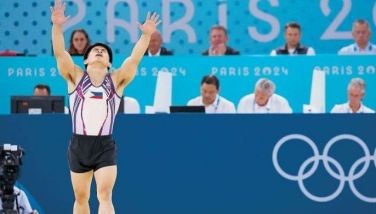RP urged to maintain position vs tariff cuts in WTO’s NAMA talks
June 18, 2006 | 12:00am
The Philippine government should stick to its position opposing more tariff reductions being proposed by developed countries under the non-market agricultural access (NAMA) negotiations of the World Trade Organization (WTO).
Non-government organizations like Tambuyog Development Center (TDC) which are providing inputs to the RP-WTO negotiators in the ongoing WTO talks in Geneva, said the developed countries’ proposal on NAMA has not changed since the last ministerial conference in Hong Kong last December and in the resumption of talks last March.
Arsenio Tanchuling, executive director of TDC, a fishery NGO, said the developed countries’ proposal for tariff reduction formula coefficients of 10 and 15 percent, respectively, is unacceptable because the difference of only five points is not enough to ensure protection for local industries.
"This proposal is contrary to the Doha principles of less than full reciprocity‚ and ‘special and differential treatment’ for developing countries. Our negotiators must not agree to this proposal and instead push for a coefficient of not less than 30 percent which is the position of the NAMA 11 group of countries that includes the Philippines," said Tanchuling.
Besides the Philippines, NAMA 11 consists of Argentina, Brazil, Egypt, India, Indonesia, Namibia, Pakistan, South Africa, Tunisia and Venezuela.
Tanchuling noted that aside from a "no less than 30" coefficient, NAMA 11 is pushing for a mark-up of 30 percentage points for unbound tariffs before they are subjected to binding or tariff reduction using the so-called Swiss formula.
He said that on the other hand, developed countries want a much lower five percent mark-up.
In addition, NAMA 11 proposes higher figures for paragraph 8 of the NAMA text that offers flexibilities for developing countries.
Under paragraph 8 (a) on tariff lines to be reduced by only half the formula cut, NAMA 11 wants 15 percent of tariff lines to be covered instead of the 10 percent presently stated in the NAMA text.
Moreover, under paragraph 8 (b) on tariff lines to be exempted from tariff reduction, NAMA 11 wants the exemption to cover 10 percent of tariff lines instead of the five stated in the NAMA text.
Tanchuling added that the NAMA 11 position, while not ideal, offers some policy space by which developing countries like the Philippines can maneuver to ensure protection to local industries and promote their development, including the fisheries industry.
In the Hong Kong talks last year, Philippine fisherfolks organizations demanded that the Philippine negotiators push for the increase in the number of non-agricultural products that will continue to be excluded from further tariff cuts under NAMA.
The fishery sector said raising the current five percent flexibilities allowed under the existing WTO ministerial text to at least 10 percent will ensure that the domestic fishing industry, especially artisinal or subsistence fishermen, are protected from the expected fish import surges if the government commits to bind more non-agricultural products.
Non-government organizations like Tambuyog Development Center (TDC) which are providing inputs to the RP-WTO negotiators in the ongoing WTO talks in Geneva, said the developed countries’ proposal on NAMA has not changed since the last ministerial conference in Hong Kong last December and in the resumption of talks last March.
Arsenio Tanchuling, executive director of TDC, a fishery NGO, said the developed countries’ proposal for tariff reduction formula coefficients of 10 and 15 percent, respectively, is unacceptable because the difference of only five points is not enough to ensure protection for local industries.
"This proposal is contrary to the Doha principles of less than full reciprocity‚ and ‘special and differential treatment’ for developing countries. Our negotiators must not agree to this proposal and instead push for a coefficient of not less than 30 percent which is the position of the NAMA 11 group of countries that includes the Philippines," said Tanchuling.
Besides the Philippines, NAMA 11 consists of Argentina, Brazil, Egypt, India, Indonesia, Namibia, Pakistan, South Africa, Tunisia and Venezuela.
Tanchuling noted that aside from a "no less than 30" coefficient, NAMA 11 is pushing for a mark-up of 30 percentage points for unbound tariffs before they are subjected to binding or tariff reduction using the so-called Swiss formula.
He said that on the other hand, developed countries want a much lower five percent mark-up.
In addition, NAMA 11 proposes higher figures for paragraph 8 of the NAMA text that offers flexibilities for developing countries.
Under paragraph 8 (a) on tariff lines to be reduced by only half the formula cut, NAMA 11 wants 15 percent of tariff lines to be covered instead of the 10 percent presently stated in the NAMA text.
Moreover, under paragraph 8 (b) on tariff lines to be exempted from tariff reduction, NAMA 11 wants the exemption to cover 10 percent of tariff lines instead of the five stated in the NAMA text.
Tanchuling added that the NAMA 11 position, while not ideal, offers some policy space by which developing countries like the Philippines can maneuver to ensure protection to local industries and promote their development, including the fisheries industry.
In the Hong Kong talks last year, Philippine fisherfolks organizations demanded that the Philippine negotiators push for the increase in the number of non-agricultural products that will continue to be excluded from further tariff cuts under NAMA.
The fishery sector said raising the current five percent flexibilities allowed under the existing WTO ministerial text to at least 10 percent will ensure that the domestic fishing industry, especially artisinal or subsistence fishermen, are protected from the expected fish import surges if the government commits to bind more non-agricultural products.
BrandSpace Articles
<
>
- Latest
- Trending
Trending
Latest



























